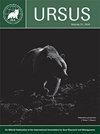On evaluating the efficacy of air-borne synthetic aperture radar for detecting polar bears: A pilot study
IF 0.8
4区 生物学
Q4 ZOOLOGY
引用次数: 0
Abstract
Knowing the location of polar bears (Ursus maritimus) in their winter dens is crucial for minimizing disturbance during this critical period in their life cycle. Previous research has used Forward Looking Infrared (FLIR) technology to detect bear dens but has only achieved a detection accuracy of 45% for single flights. The thermal nature of FLIR means that some bears are never detected nor are detectable using FLIR. In this paper we explore the use of Synthetic Aperture Radar (SAR) as an alternative polar bear detection technology in a simple pilot study in Churchill, Manitoba, Canada, during October 2021. In this experimental study, we focused on the detection of polar bears on the surface in the SAR images. The result of this study can inform future efforts to proceed to den-detection experiments. In this study, we achieved a polar bear identification accuracy of 66%, albeit with a small sample size. Many of the challenges we encountered involved low signal-to-noise ratios and imprecise flight paths. Concurrent research from other parties shows that neural networks and other machine learning techniques can overcome these challenges to some degree, suggesting that SAR may be a promising candidate to become an effective tool for polar bear detection, particularly when coupled with other sensors such as FLIR.评价机载合成孔径雷达探测北极熊的效能:初步研究
在北极熊生命周期的这个关键时期,了解北极熊(Ursus maritimus)在冬季洞穴中的位置对于最大限度地减少干扰至关重要。以前的研究使用前视红外(FLIR)技术来探测熊窝,但单次飞行的探测精度仅为45%。前视红外的热特性意味着一些熊从未被探测到,也不会被前视红外探测到。在本文中,我们将于2021年10月在加拿大马尼托巴省丘吉尔市进行一项简单的试点研究,探索合成孔径雷达(SAR)作为替代北极熊探测技术的使用。在本实验研究中,我们重点研究了在SAR图像中对地表北极熊的检测。这项研究的结果可以为未来进行洞穴探测实验提供信息。在这项研究中,我们实现了66%的北极熊识别准确率,尽管样本量很小。我们遇到的许多挑战涉及低信噪比和不精确的飞行路径。来自其他方面的同步研究表明,神经网络和其他机器学习技术可以在一定程度上克服这些挑战,这表明SAR可能成为北极熊探测的有效工具,特别是当与其他传感器(如FLIR)结合使用时。
本文章由计算机程序翻译,如有差异,请以英文原文为准。
求助全文
约1分钟内获得全文
求助全文
来源期刊

Ursus
生物-动物学
CiteScore
2.00
自引率
15.40%
发文量
12
审稿时长
>12 weeks
期刊介绍:
Ursus includes a variety of articles on all aspects of bear management and research worldwide. Original manuscripts are welcome. In addition to manuscripts reporting original research, submissions may be based on thoughtful review and synthesis of previously-reported information, innovative philosophies and opinions, and public policy or legal aspects of wildlife conservation. Notes of general interest are also welcome. Invited manuscripts will be clearly identified, but will still be subject to peer review. All manuscripts must be in English. All manuscripts are peer-reviewed, and subject to rigorous editorial standards.
 求助内容:
求助内容: 应助结果提醒方式:
应助结果提醒方式:


